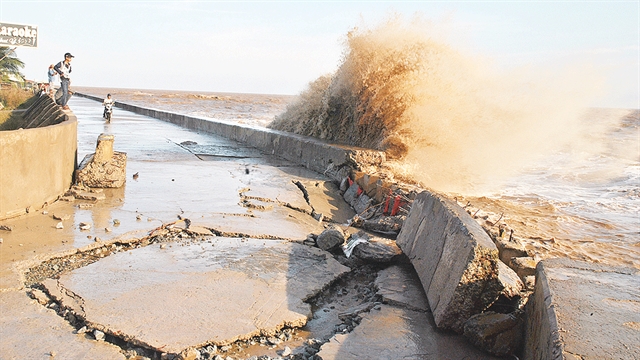 Environment
Environment

The damage caused by landslides in the Mekong Delta provinces has been increasing yearly.

|
| Landslides on the Cà Mau peninsula have become increasingly worse. — Photo: sggp.org.vn |
HCM CITY— The damage caused by landslides in the Mekong Delta provinces has been increasing yearly.
Localities such as Cà Mau, Đồng Tháp, An Giang, Tiền Giang, and Bạc Liêu have declared a state of emergency because of landslides. Solutions to limit the damage caused by landslides in the Mekong Delta are now a top priority.
The Mekong Delta was formed by sand and alluvial soil over the last 6,000 years. In that process, it was natural to see one side of a riverbank wider than the other side. However, according to scientists, since 2005 there have been more landslides than land accretion in the Mekong River Delta provinces.
The Mekong Delta region loses about 50 metres of land each year, causing a serious threat to people living along the riverbanks in the region.
Nguyễn Hữu Thiện, an independent expert on Mekong Delta ecology, told Sai Gòn Giải Phóng (Liberated Sài Gòn) newspaper that landslides are caused mostly by a shortage of sand, the blockage of alluvial soil by many hydropower dams, and the mass exploitation of sand along the Mekong River.
The most serious problem is the massive illegal sand mining occurring in Cambodia and Việt Nam, Thiện said.
According to statistics from the International Commission of Mekong Sub Region, between 1992 and 2014, the total volume of alluvial soil of the Mekong River dropped by 50 per cent – from 160 million tonnes down to 85 million tonnes.
Scientists warn that the lack of alluvial soil could cause the number of landslides to increase rapidly in the next five to 10 years.
In recent years, the coast of the Mekong Delta has lost about 500 ha of land annually, but it could begin losing thousands of hectares of land each year in the next 10 years.
Over the past few years, the Government has invested trillions of dong to build landslide prevention works in Mekong Delta provinces.
Many provinces have asked for support from the government to fund landslide prevention and relocate people living in areas at high risk of landslides.
However, according to Thiện, what should be done now is to take action to minimise the losses or damage to local people.
There are three actions – first, build projects in weak soil areas with a high population and in villages living along the riverbanks. For people living in the countryside along the riverbanks, the local authorities should develop plans to persuade them to move to safer places. And thirdly, authorities should develop more plans to prevent illegal sand exploitation.
The Mekong Delta has more than 500 areas with riverbank erosion with a total length of 520km, and over 50 areas of coastal erosion with a total length of 266km, according to the Việt Nam Disaster Management Authority
More than 28,000 ha of forests have been lost in the last 20 years. VNS




